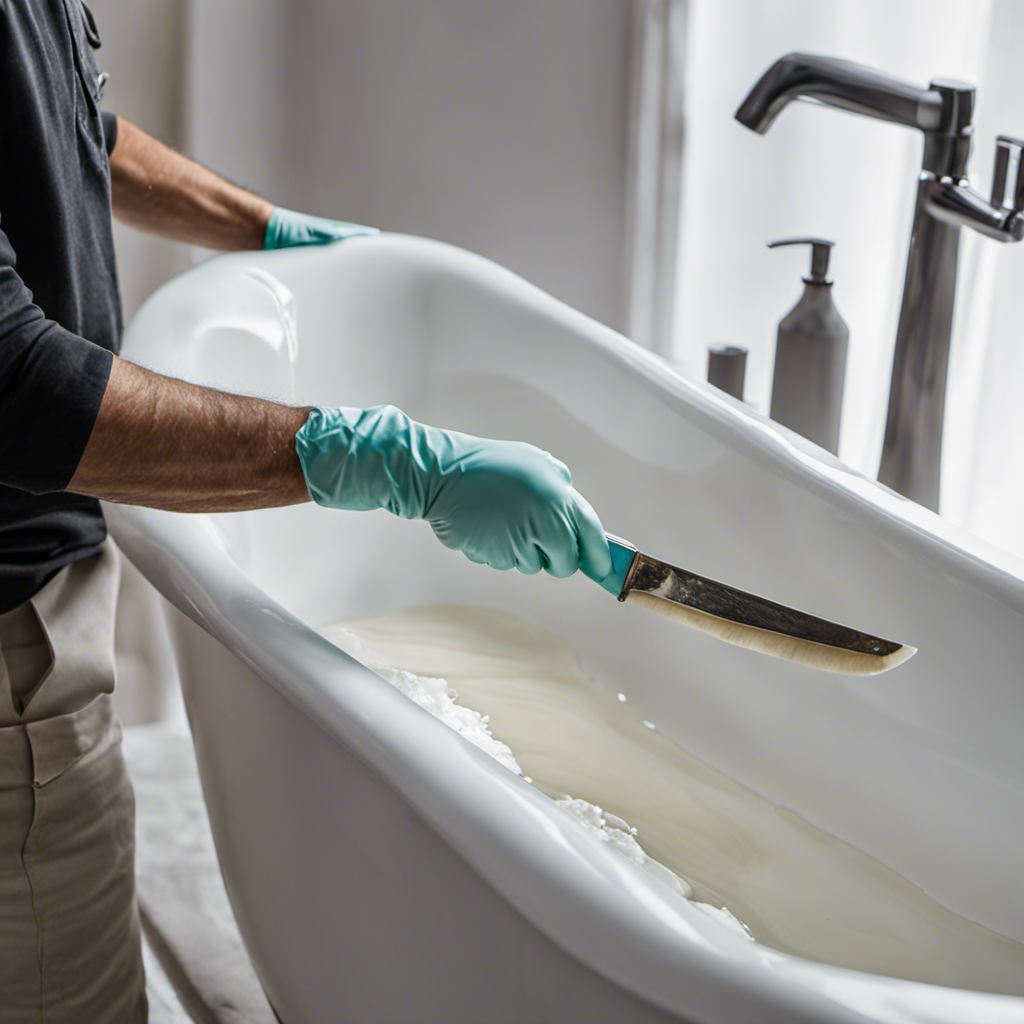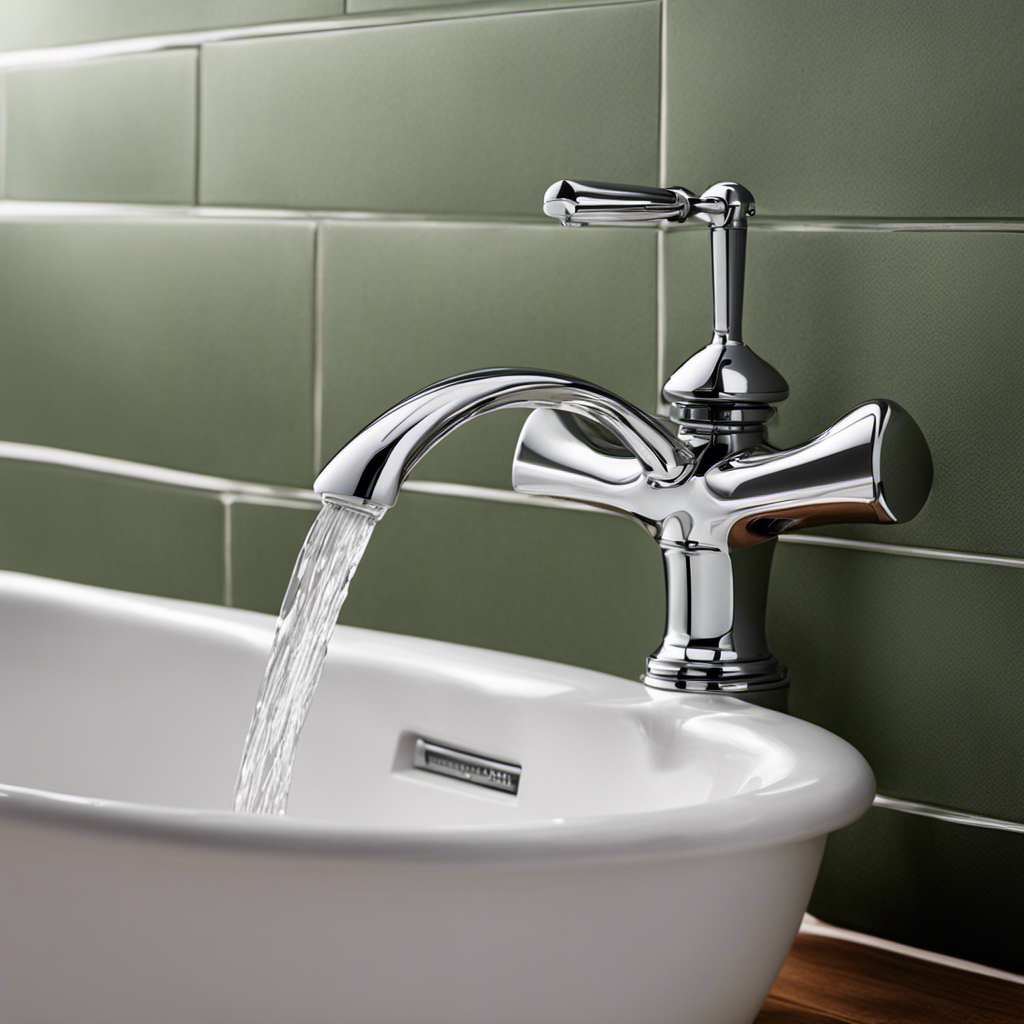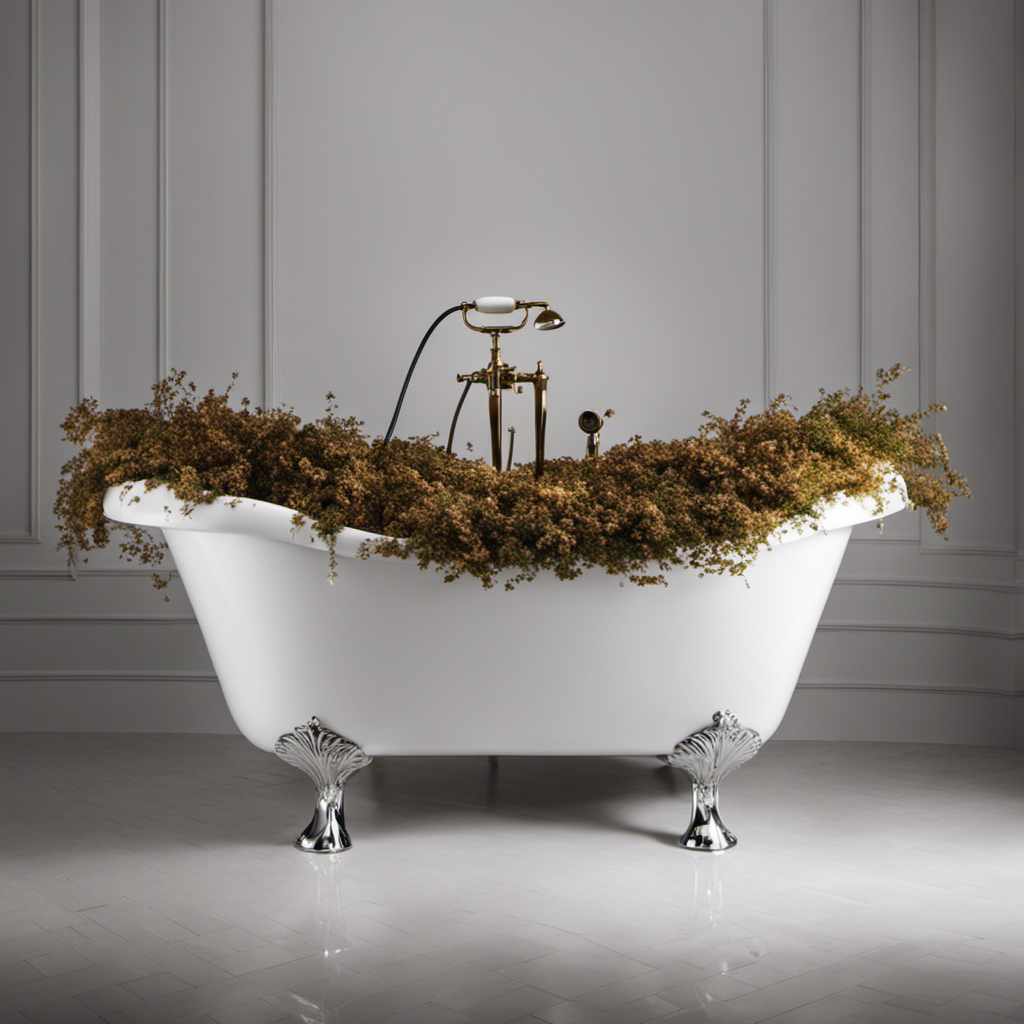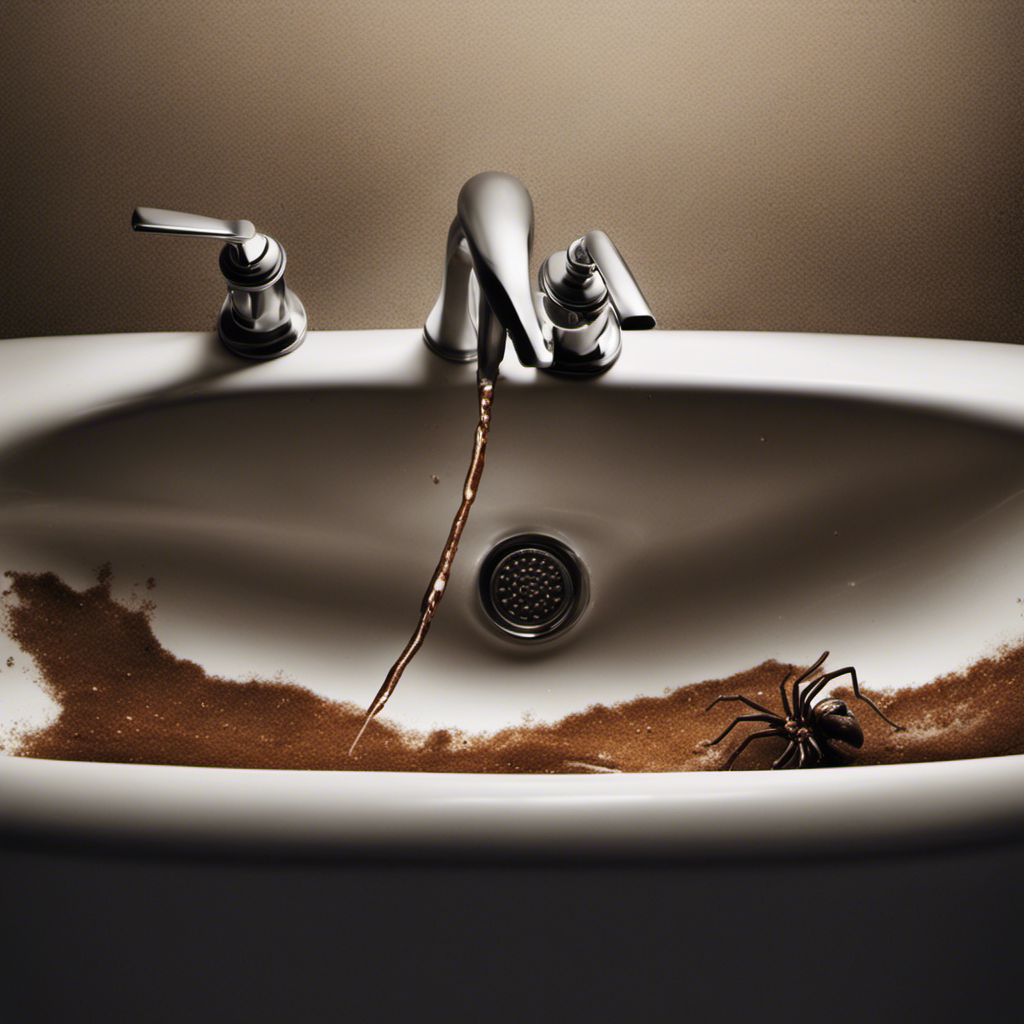I’ve discovered that a staggering 70% of homeowners have encountered the frustration of a hole in their bathtub. But fear not! In this step-by-step guide, I’ll show you how to patch that hole and restore your bathtub to its former glory.
We’ll start by assessing the damage and gathering the necessary tools and materials. Then, we’ll prep the surface and apply the patching material, followed by smoothing and finishing the patch. Finally, we’ll allow the patch to cure, ensuring a durable and long-lasting solution.
Let’s get started!
Key Takeaways
- Assess the size of the hole and evaluate repair options based on factors such as location, budget, and time constraints.
- Gather essential tools and materials such as a utility knife, sandpaper, putty knife, drill, fiberglass patch kit, epoxy resin, and acetone.
- Regularly inspect and select the appropriate tools and repair method based on the extent of the damage.
- Take safety precautions by wearing a respirator mask and safety goggles, and properly prepare the surface by cleaning, removing old caulk, and sanding before applying the patching material.
Assessing the Damage
You should start by assessing how big the hole is and if there are any other damages in the bathtub.
First, inspect the hole closely to determine its size. Use a measuring tape or ruler to measure the length and width of the hole.
Next, check for any surrounding cracks or chips in the bathtub surface. These can indicate further damage that needs to be addressed.
Once you have assessed the damage, you can proceed to evaluate repair options. Consider the size and location of the hole, as well as your budget and time constraints.
Some repair options include using a bathtub repair kit, applying a patch, or hiring a professional to fix the hole.
Gathering the Necessary Tools and Materials
When it comes to tackling any project, having the right tools and materials is essential. In order to ensure a successful outcome, it is important to carefully select the appropriate tools for the task at hand.
Additionally, it is crucial to consider safety precautions in order to protect yourself and others from potential hazards.
Essential Tools and Materials
To patch a hole in your bathtub, gather the essential tools and materials. Here are the tools and materials you will need:
-
Tools:
-
Utility knife
-
Sandpaper
-
Putty knife
-
Drill
-
Mixing paddle
-
Materials:
-
Fiberglass patch kit
-
Epoxy resin
-
Hardener
-
Fiberglass cloth
-
Acetone
Before starting the patching process, it’s important to ensure that your tools are properly maintained. Sharpen the utility knife and clean the sandpaper to ensure optimal performance. Additionally, consider alternative patching methods such as using a bathtub repair kit or a waterproof sealant. These options may provide a temporary fix until a proper repair can be made.
Proper tool selection is crucial in effectively patching a hole in your bathtub.
Proper Tool Selection
One important factor to consider in effectively patching a bathtub is the proper selection of tools. Tool maintenance is crucial for ensuring optimal performance and longevity. Regularly inspecting and cleaning your tools will prevent rust, debris buildup, and other potential issues.
When it comes to patching a bathtub, there are alternative repair methods that can be considered, depending on the extent of the damage. For small holes or cracks, a bathtub repair kit can be used. This typically includes epoxy or fiberglass resin, a mixing tool, and a patching material.
For larger holes or more extensive damage, a bathtub liner or professional repair services may be necessary. It is important to carefully assess the damage and select the appropriate tools and repair method for a successful bathtub patch.
Safety Precautions to Consider
It’s important to consider safety precautions when working on bathtub repairs. This includes wearing protective gloves and goggles. Taking respiratory protection and eye protection into account is crucial to ensure your safety during the repair process.
Here are the steps to follow:
- Wear a respirator mask to protect your respiratory system from inhaling harmful fumes or dust particles.
- Put on safety goggles to shield your eyes from any potential debris or chemicals that may cause harm.
By taking these safety precautions, you minimize the risk of respiratory and eye injuries while repairing your bathtub.
Now that we have covered the safety aspect, let’s move on to preparing the surface for patching.
Preparing the Surface for Patching
Before patching the hole in the bathtub, it’s important to properly prepare the surface.
First, I’ll clean the area using a mild detergent and water to remove any dirt, grime, or soap scum.
Next, I’ll carefully remove any old caulk using a caulk remover tool or a utility knife, ensuring that the surface is clean and smooth.
Cleaning the Surface
To clean the surface, start by scrubbing it with a mixture of baking soda and vinegar. This cleaning technique is effective in removing dirt, grime, and soap scum from the bathtub surface. Here are the steps to follow:
- Create a cleaning solution by mixing equal parts of baking soda and vinegar in a bowl.
- Using a sponge or a soft cloth, dip it into the cleaning solution and start scrubbing the bathtub surface in circular motions.
- Pay special attention to areas with stubborn stains or buildup.
- Rinse the surface thoroughly with water to remove any residue.
- Dry the surface with a clean towel or allow it to air dry.
Removing Old Caulk
When removing old caulk, you can use a caulk removal tool or a utility knife to carefully cut along the edges of the caulk line. Begin by examining the caulk line to identify any loose or damaged areas. If the caulk is cracking or peeling, it is important to remove it completely before patching the hole in the bathtub.
Using a caulk removal tool or a utility knife, gently score along the edges of the caulk line, being careful not to damage the surrounding surfaces. Once the caulk line has been scored, use a putty knife or a scraper to carefully pry away the old caulk. Take your time and work methodically to ensure that all traces of the old caulk are removed.
Proper caulk removal techniques will ensure a clean surface for the next step of patching the hole.
Sanding the Area
Start by gently sanding the area around the old caulk to create a smooth surface for the new caulk to adhere to. This step is crucial for ensuring a proper bond between the new caulk and the bathtub surface. Here’s how to do it effectively:
-
Gather the necessary materials: sandpaper (150-grit or higher), a sanding block, and a damp cloth.
-
Clean the area by removing any dirt, debris, or loose caulk with the damp cloth.
-
Attach the sandpaper to the sanding block, ensuring it is secure.
-
Use the sanding block to sand the area in a circular motion, applying light pressure. Be careful not to sand too aggressively, as this may damage the bathtub surface.
-
Continue sanding until the surface feels smooth to the touch and any uneven or rough areas are leveled.
-
After sanding, wipe away any dust or residue with the damp cloth.
-
Inspect the sanded area for any remaining gaps or imperfections that need filling.
Applying the Patching Material
Once you’ve mixed the patching material, it’s time to apply it to the hole in your bathtub.
To ensure a successful repair, it is crucial to follow the proper application technique and choose the right patching material.
Begin by using a putty knife to scoop a small amount of the mixed patching material onto the blade.
Apply the patching material directly onto the hole, making sure to fill it completely.
Use the putty knife to smooth out the patch, ensuring it is level with the surrounding area.
Apply light pressure to the patching material to ensure it adheres properly.
Once the patch has been applied, allow it to dry according to the manufacturer’s instructions.
This will create a strong bond and prepare the patch for smoothing and finishing in the next step.
Smoothing and Finishing the Patch
To achieve a seamless repair, you’ll want to carefully smooth and finish the applied patching material. Here are the steps to follow for smoothing and finishing the patch:
-
Use a putty knife or a drywall knife to scrape off any excess patching material from the surface of the bathtub. Make sure to remove any bumps or ridges for a smooth finish.
-
Once the excess material is removed, lightly sand the patched area with fine-grit sandpaper. This will help to blend the patch with the surrounding surface.
-
After sanding, wipe down the area with a damp cloth to remove any dust or debris.
-
Apply a thin layer of primer to the patched area to promote better adhesion and to ensure a uniform finish.
-
Finally, once the primer has dried, you can apply a coat of paint or bathtub refinishing product to match the color of your bathtub.
By following these smoothing techniques and finishing touches, you can achieve a professional-looking repair.
Now, let’s move on to the next step of allowing the patch to cure.
Allowing the Patch to Cure
After applying the patching material, you’ll need to allow it to cure before moving on to the next step. The curing time is an essential part of the patching process as it ensures that the material sets properly and provides a durable repair.
The exact curing time will depend on the type of patching material you are using, so be sure to consult the manufacturer’s instructions for specific guidance. Generally, it is recommended to allow the patch to cure for at least 24 hours.
During this time, it is important to avoid using the bathtub or applying any additional pressure to the patched area. This will allow the patch to fully harden and achieve its maximum strength.
Following the recommended curing time will ensure the longevity of your repair and prevent any future issues.
Conclusion
So there you have it, folks! Patching a hole in your bathtub is a simple and straightforward process.
By assessing the damage, gathering the necessary tools and materials, preparing the surface, applying the patching material, and smoothing and finishing the patch, you can ensure a seamless repair.
Don’t forget to allow the patch to cure properly for a long-lasting result.
Remember, with a little patience and attention to detail, you can achieve a perfectly patched bathtub in no time!










